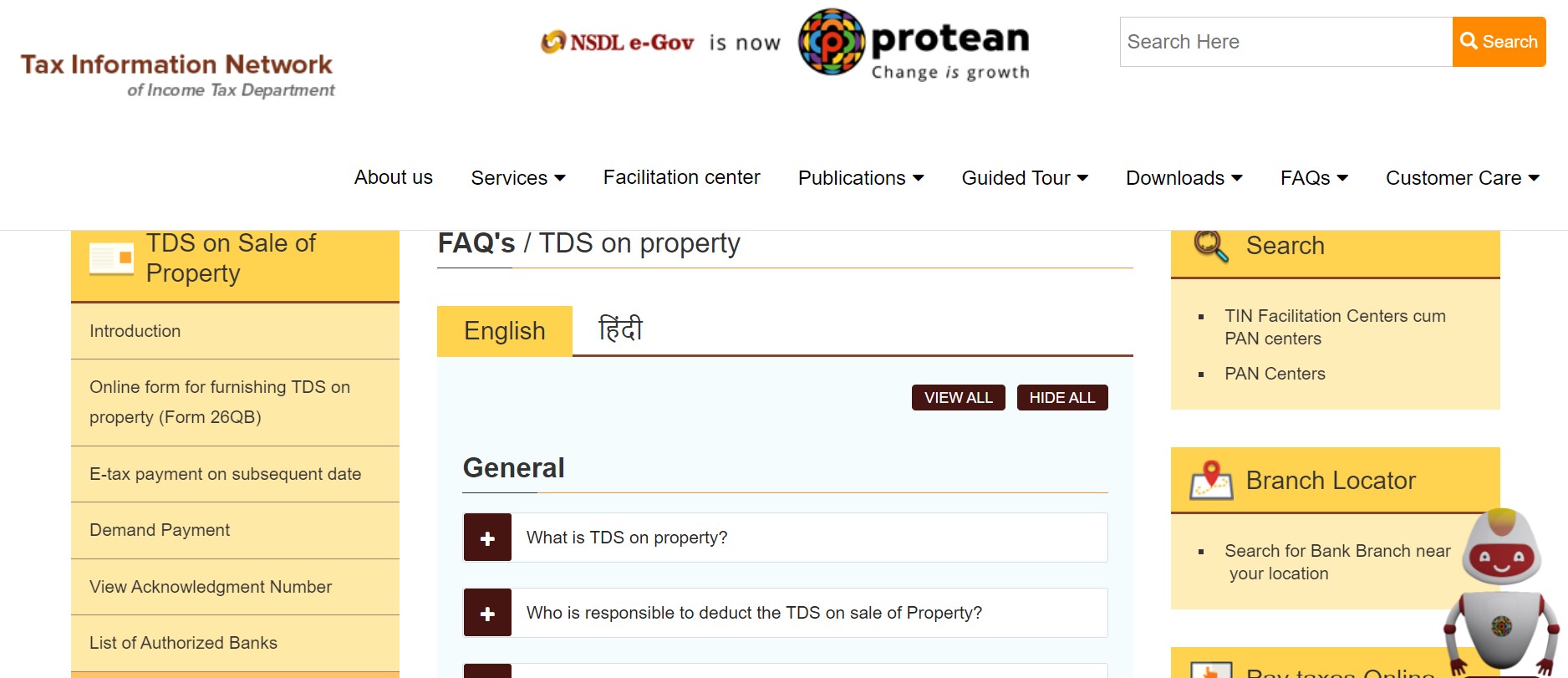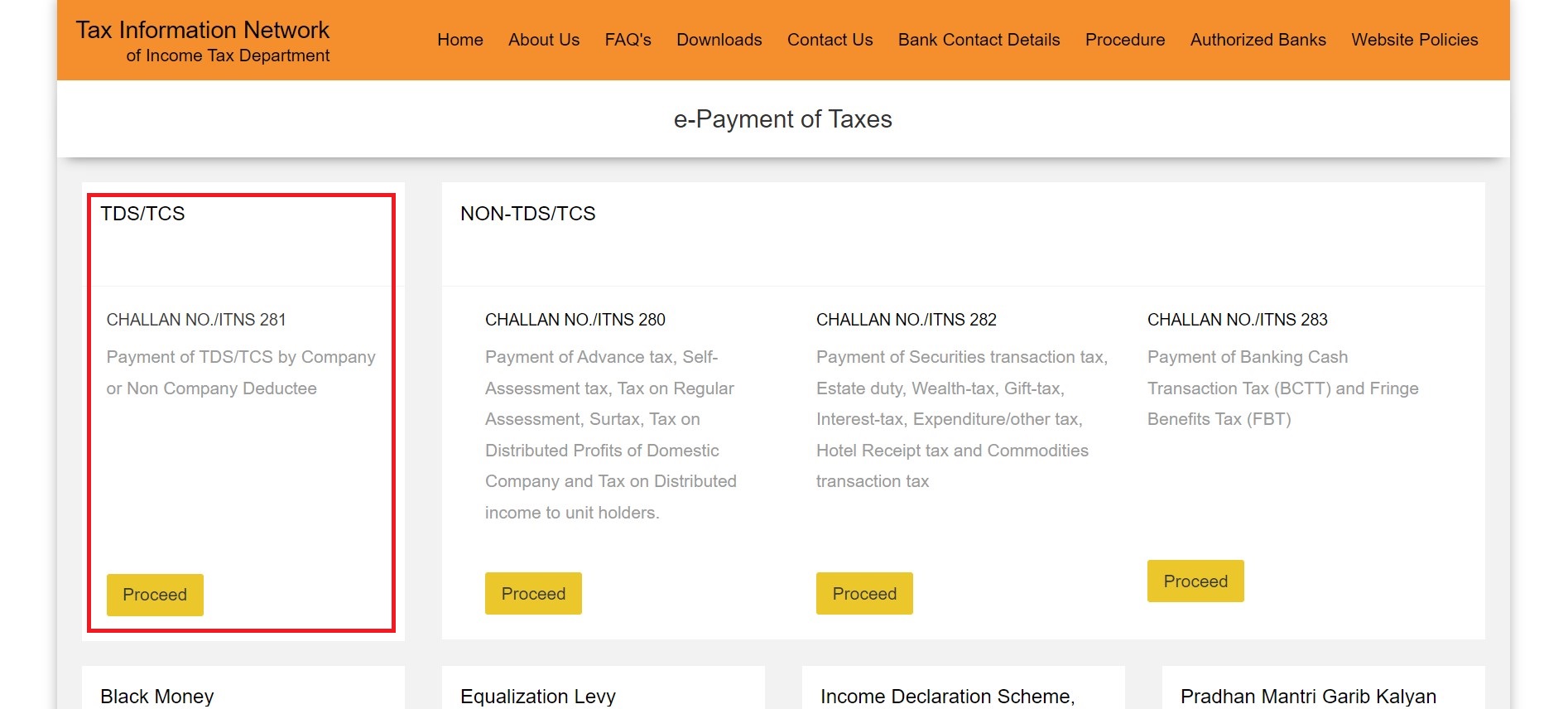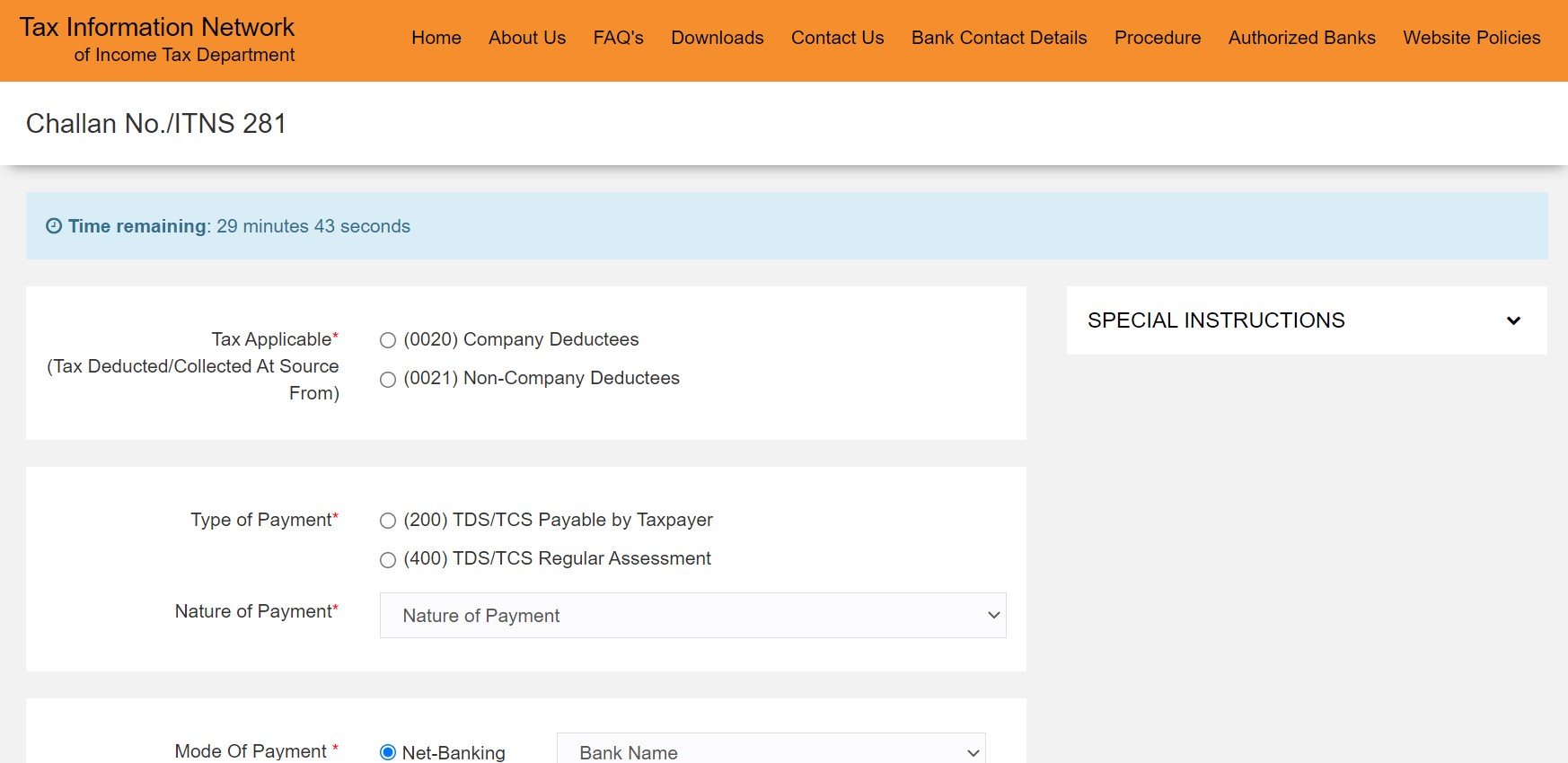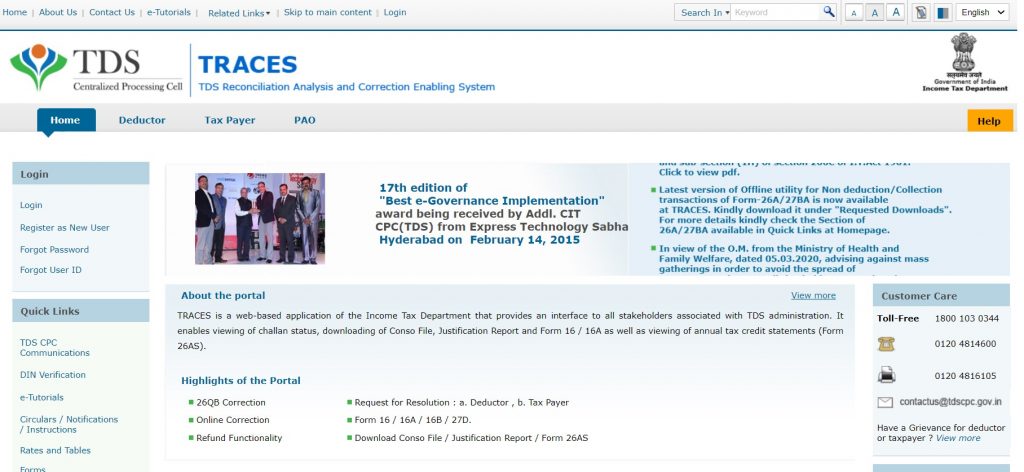How To Pay TDS Online: A Step-By-Step Guide

Employees need to pay taxes to the Government each year. To make paying taxes easier for the taxpayers, the Indian Government has introduced TDS (Tax Deducted at Source). TDS is deducted by the employer each month and paid to the Government every year within a specified timeline. If you are an employer and want to pay TDS online, here’s a step-by-step guide to do so easily. Keep reading!
Why TDS was Introduced?
TDS aims to collect tax directly from the source of income. The employer/person who is liable to make payments to another person is responsible for deducting the tax at source and submitting the same to the Government of India.
As per income tax rules, the deductee is eligible to get credits for the amount deducted through Form 26AS/TDS certificate.
How to Pay TDS Online?
In India, TDS e-payment is offered by National Securities Depository Limited. All you have to do is follow these nine easy steps to pay TDS online:
- Step 1: Visit NSDL’s official website.
Click on NSDL to go to the NSDL e-Gov website

- Step 2: Go to ‘Services’
Hover your anchor around the top navigation bar, and from the “Services” dropdown menu, click on “e-payment: Pay Taxes Online.”

- Step 3: Select “CHALLAN NO./ITNS 281”
From the list of challans, select CHALLAN NO./ITNS 281 and click on ‘Proceed’. Anew page will open up.

- Step 4: Fill out Challan 281
1. Select a ‘Tax Applicable’ category: Company Deductees or Non-Company Deductees.
2. Fill out your Tax Deduction Account Number (TAN) and assessment year (AY).
3. It is mandatory to select your PIN code and State from the dropdown menu.
4. Select “Type of payment”: TDS payable by taxpayer or TDS on regular assessment.
5. Lastly, opt for the nature and mode of payment before clicking entering the Captcha and hit “Proceed”
After verifying your TAN, the taxpayer’s name will get displayed on the screen.
- Step 5: Confirm all data.
Check your data and confirm. You will get redirected to your bank’s net banking site.
- Step 6: Complete Payment
Log in to your banking profile and make the requested payment.
After the successful payment, you will see a challan counterfoil containing your CIN, payment details, and bank name. As this challan counterfoil is proof of your payment, it is vital to store it for future reference.
Benefits of Online TDS Payment
Here are the benefits of online TDS payment:
- Deductors can make TDS payments at their convenience
- Acknowledgement of online payment is received instantly
- One can download and save the TDS payment challan acknowledgement copies for reference
- Decreases the chances of corruption
- Constant availability of TDS payment facilities
- TDS E payment is environment friendly
How to Check TDS Payment Status Online?
To check whether the e-filing of TDS payment by the deductor is successful or not, you can follow these steps:
Step 1: Visit the official TRACES (TDS Reconciliation Analysis and Correction Enabling System) website.

Step 2: Enter the verification code and click on “Proceed.”
Step 3: Provide the deductee’s PAN details and the deductor’s TAN details.
Step 4: From the dropdown menu, select financial year, quarter, and type of return.
Step 5: Finally, click on “Go” to view your TDS status.
However, there is another procedure that you can follow to view your TDS status without using your PAN card. For that, you have to follow these steps:
Step 1: Visit the Income Tax Department’s official portal.
Step 2: A new member needs to register themselves. Meanwhile, an existing member can log in with his/her User ID and password.
Step 3: From the “My Accounts” tab, select “View Form 26AS.”
Step 4: Select the relevant “Year” and “PDF Format” to download the file.
Step 5: You can access this file using your date of birth as your password and view your TDS status.
Also Read: A Detailed Guide For Checking TDS Status Using Your PAN Card
Timeline for TDS Payment Online
The deadline for completing TDS payments varies for government and non-government assessees.
Due dates for government assessees are as follows:
- For tax payment without challan: The day of deduction
- For tax payment with challan: 7th of next month (for example, the deductor has to pay TDS for the month of February, by March 7)
Due dates for non-government assessees are given below:
- Payment of TDS for March: April 30 of that year
- Payment of TDS for every other month: 7th of next month
Quarterly payment
Only with the permission of the Joint Commissioner, taxpayers can pay TDS every quarter. The deadlines for these payments are as follows:
- Quarter ending on June 30th: July 7
- Quarter ending on September 30th: October 7
- Quarter ending on December 30th: January 7
- Quarter ending on March 30th: April 7
TDS Payment Applicability
Given below are important points related to TDS payment applicability:
- Individuals and HUFs need to deduct TDS if the revenue exceeds Rs. 1 crore for corporations.
- TDS has to be deducted if revenue exceeds Rs. 50 lakh in case of professions.
Additional Fees Associated In Case of Non-Payment of TDS
Section 234E of ITA states the guidelines in case of delay in TDS payment.
If a taxpayer fails to pay TDS on the stipulated date, then he/she has to pay Rs. 200 as a fine for every day until the amount has been paid.
How to Pay TDS Outstanding Amount?
Given below are the steps to pay TDS outstanding amount with Challan ITNS 281:
Step 1: Visit the official website of NSDL.
Step 2: Select the Pay Taxes Online option under the ‘Services’ tab on the homepage.
Step 3: Choose Challan ITNS 281 for demand payment.
Step 4: Select major head. Provide the TAN, address, assessment year, minor head/type of payment, nature and mode of payment and bank name. Then click on ‘proceed’.
Step 5: The screen will display the information provided. You need to confirm it and then click on the ‘submit to bank’ button.
Step 6: You will be redirected to the bank’s website where you need to provide your user ID and password.
Step 7: Provide the payment details and make the TDS payment.
How to File TDS Returns?
Given below are the steps to file TDS returns:
Step 1: Visit the official website of NSDL where the data structure of e-TDS/e-TCS is given.
Step 2: You need to prepare your e-TDS/e-TCS as per the format provided in clean ASCII format with ‘.txt’ as file name extension. Keep in mind that the e-TDS return can be filed using Return Preparation Utility provided by NSDL.
Step 3: You need to verify the file using the File Validation Utility.
Step 4: The FVU will provide the error report if the file has an error.
Step 5: You can submit the .fvu file at TIN-FC or upload it on the official website of NSDL
Forms Associated with TDS Returns
Given below is the list of the forms associated with TDS returns:
- Form 24Q
Quarterly statement for TDS deducted from salaries.
- Form 26Q
Quarterly statement for TDS deducted for payments other than salaries.
- Form 27Q
Quarterly statement of TDS from interest, dividend or any sum payable to NRIs.
- Form 27EQ
Quarterly statement of collection of TDS.
Consequences of Missing the Deadline of TDS Payment
- TDS not deducted
If you delay in deducting TDS and thus, end up not meeting the TDS payment deadline, the deductor is liable to pay interest. From the due day of deduction to when the deductor actually collects TDS, interest at the rate of 1% is charged per month on the due amount.
- TDS deducted but payment not made
Under Section 201A of the Income Tax Act, a non-payment of TDS carries an interest of 1.5% per month on the due amount. This penalty applies from the day of the TDS deduction to the day of successful payment.
Also Read: All PAN Card Services At NSDL
What is TAN?
Tax Deduction and Collection Account Number is commonly referred to as TAN. It is a 10-digit alphanumeric number issued by the Income Tax department.
The Government of India has made TAN mandatory for individuals and businesses.
As per Section 203A of the Income Tax Act, one needs to mention the TAN while filing TDS returns.
How Can You Apply for TAN?
Given below are the steps to apply for TAN online:
Step 1: Visit the official website of NSDL and choose ‘Online Application for TAN’ (Form 49B).
Step 2: From the drop-down menu, opt for the category of deductors and choose the ‘Select Button’.
Step 3: Fill up the form.
Step 4: If the details submitted do not pass through any format level validation, the screen will display the error.
Step 5: If there is an error, the individual has to rectify it and re-submit it.
Step 6: If the form contains no error, then a confirmation screen will be displayed.
Step 7: Applicant needs to confirm if the information displayed on the screen is correct or not.
Step 8: After the applicant has paid the requisite fees successfully, an acknowledgement form will be generated.
Step 9: Finally, the applicant needs to submit the hard copy of the acknowledgement form along with all the documents at the following address:
NSDL e-Governance Infrastructure Limited,
5th floor, Mantri Sterling,
Plot No. 341, Survey No. 997/8,
Model Colony,
Near Deep Bungalow Chowk,
Pune – 411016
The applicant needs to write ‘APPLICATION FOR TAN – Acknowledgment Number’ (e.g. ‘APPLICATION TAN – 88301020000244’).
Final Word
Tax Deducted at Source is crucial as it protects the tax system against individuals who indulge in tax evasion. Fortunately, with digitalisation, you can now pay TDS online from anywhere without submitting a physical challan.
FAQs on Pay TDS Online
Ans: Follow these steps to know your TAN:
Step 1: Visit the official website of Income Tax e-Filing website
Step 2: Select ‘Know your TAN’; go to ‘Name’ under the ‘TAN Search’ option
Step 3: Choose a Category of Deductor
Step 4: Provide state, name, and the registered mobile number and click on ‘continue’
Step 5: Provide the OTP and finally click on ‘Validate’
Ans: When there is a mistake in data entry, mistake in challan and mistake in calculations, people may end up paying less. This is known as short payment. It can be solved through conso file request on Traces and a direct request for correction.
Ans: According to the Income Tax mandate, you need to pay a month’s TDS amount on the 7th of the coming month. In the case of TDS deducted in March, the payment deadline is April 30. However, with the permission of the Joint Commissioner, you can make these payments every quarter.
Ans: Yes, if you pay more tax than what you owe, you will get a refund. This applies to Tax Deducted at Source as well. To obtain refunds, you will have to file the income tax return on time and show the TDS amount.
Ans: No, as per the norm, any individual who earns an annual income above Rs. 2.5 lakh has to pay TDS. Thus, both salaried and self-employed individuals have to pay income tax before the deadline.
Ans: Form 26AS includes all the details about a taxpayer’s tax credit. Thus, it gives you information about the amount deducted as TDS or TCS, any advance tax you pay, the tax refunds you receive in a financial year, etc.
Ans: In FY 2020-21, the Government of India introduced a new tax rate regime. This regime lowered tax rates and removed the major tax exemptions and deductions that were available in the old tax regime. However, this new regime is optional.
Disclaimer
This article is solely for educational purposes. Navi doesn't take any responsibility for the information or claims made in the blog.
Read More on Income Tax Act

What is Form 26QB for TDS? How to Download and Submit it?
While purchasing a property, buyers are liable to pay various taxes. The Finance Act, 2013 made TDS... Read More »PF Withdrawal Rules 2023 – Rules, Documents Required and Types
EPF/PF Withdrawal Employees’ Provident Fund (abbreviated as EPF) is a popular retirement sav... Read More »Stamp Duty and Property Registration Charges in Delhi 2023
It is compulsory for property buyers in the Capital to pay stamp duty in Delhi during property regi... Read More »Income Tax Return – Documents, Forms and How to File ITR Online AY 2023-24
In India, it is mandatory for all taxpayers who earn more than the basic tax exemption limit to fil... Read More »What is Section 80CCD – Deductions for National Pension Scheme and Atal Pension Yojana
The Income Tax Act provides a number of deductions and tax benefits to taxpayers, so they can strat... Read More »Tax on Dividend Income: Sources, Tax Rate and TDS on dividend income
What are Dividends? Companies may raise funds for running their operations by selling equity. Th... Read More »Section 112A of Income Tax Act: Taxation on Long-Term Capital Gains
What is Section 112A? Section 112A of the Income Tax Act was announced in Budget 2018 to replace... Read More »Section 206AB of Income Tax Act: Eligibility And TDS Rate
Section 206AB was introduced in the Finance Bill 2021 as a new provision pertaining to higher deduc... Read More »What is a Credit Note in GST – Example, Format and Steps
A GST Credit Note is mandatory for any GST-registered supplier of goods or services. As a supplier,... Read More »Exemptions and Deductions Under Section 10 of Income Tax Act
What Is Section 10 of the Income Tax Act? Section 10 of the Income Tax Act, 1961 provides tax-sa... Read More »Section 57 of the Income-tax Act – Income from Other Sources
It is quite likely that many entities - individuals as well as businesses - have multiple sources o... Read More »What is Dearness Allowance? – Types, Calculation, and Current Rate
What is Dearness Allowance? Dearness Allowance Meaning - Dearness Allowance (DA) is an allowance... Read More »Top 10 Chit Fund Schemes in India in 2023
Chit funds are one of the most popular return-generating saving schemes in India. It is a financial... Read More »10 Best Gold ETFs in India to Invest in April 2023
Gold ETFs or Gold Exchange Traded Funds are passively managed funds that track the price of physica... Read More »10 Best Demat Accounts in India for Beginners in 2023
Creation of Demat accounts revolutionised the way trades were conducted at the stock exchanges. It... Read More »20 Best Index Funds to Invest in India in April 2023
What is an Index Fund? An index fund is a type of mutual fund or exchange-traded fund (ETF) that... Read More »Best Arbitrage Mutual Funds to Invest in India in April 2023
Arbitrage funds are hybrid mutual fund schemes that aim to make low-risk profits by buying and sell... Read More »10 Best SIP Plans in India to Invest in April 2023
What is SIP? SIP or Systematic Investment Plan is a method of investing a fixed amount in ... Read More »10 Best Corporate Bond Funds in India to Invest in April 2023
Corporate bond funds are debt funds that invest at least 80% of the investment corpus in companies ... Read More »10 Best Bank for Savings Account in India [Highest Interest Rate 2023]
Savings account is a type of financial instrument offered by several banks. It lets you safely depo... Read More »






























